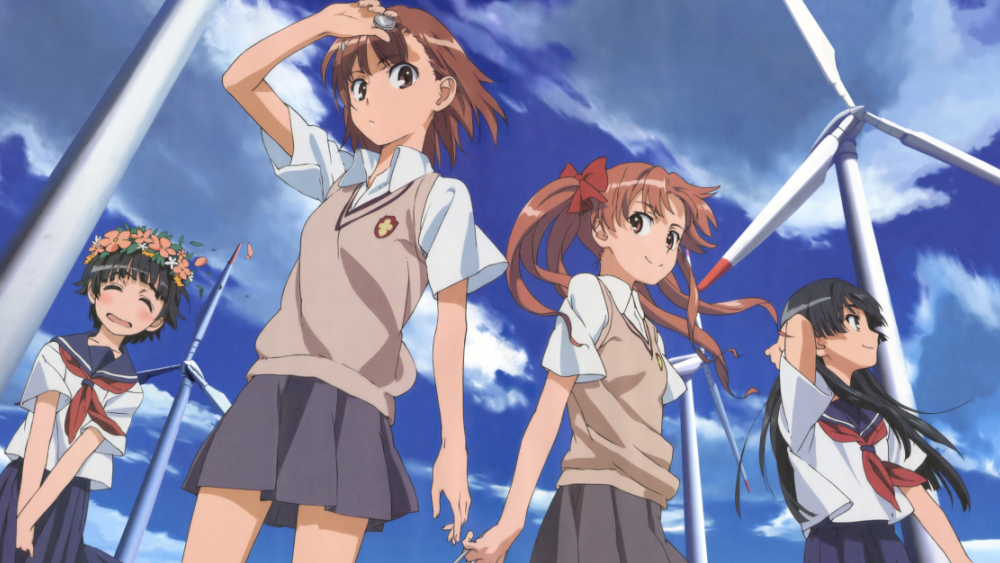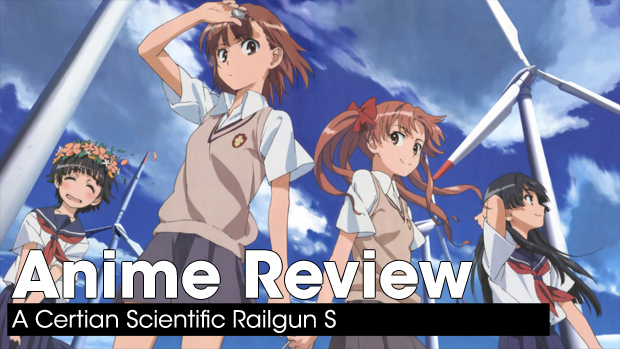Andrew Erickson reviews A Certain Scientific Railgun S
Anime Review:
A Certain Scientific Railgun S
by Andrew Erickson

First things first: A Certain Scientific Railgun S (or Railgun, for sake of convenience) is the sequel to an animated adaptation of a manga spinoff of a light novel series, and there’s very likely a layer of adaptation I’m missing here. I know next to nothing about the source material, A Certain Magical Index, so I’m approaching Railgun as a standalone work. Maybe it isn’t entirely fair, though fortunately familiarity with its sister series isn’t required to follow the plot. J.C. Staff did a fine job introducing all the necessary concepts and plot points, and at any rate I’d prefer not to have my opinion prejudiced by prior entries in the franchise, which I’ve never been interested enough to actively follow.
The setting is Academy City, a high-tech university town built to tap the human potential of espers, people born with unique supernatural powers. Espers are classified according to a ranking scheme in which the highest position is Level 5, attained by only seven people in Academy City. With the city’s blessing, a secret research institute has enacted Level 6 Shift, an experimental plan to artificially boost the city’s most powerful denizen, Accelerator, beyond Level 5. They opt to do so through combat simulations against the third best, the show’s protagonist and eponymous “railgun,” Mikoto Misaka, who can control electric currents. 20,000 simulations, as it turns out, which the researchers conduct with mass-produced clones of Misaka. Naturally, Misaka objects to this and sets out on a campaign to halt the experiments however she can (mostly by blowing stuff up, as “railgun” doesn’t exactly carry connotations of nonviolence).
It sounds like a good setup for an action-oriented series: superpowered clones and shadowy experiments set against the backdrop of a semi-futuristic city. And I’d be lying if I said there isn’t at least some promise there; despite Railgun committing the cardinal sin of making all the most prominent characters middle school students, I’m not sure anyone in Academy City actually attends school. It’s a pleasantly surprising step in the right direction, but as is all too often the case the show then takes a good three or four steps back and crams in a good dose of slice-of-life comedy. Has any show that isn’t expressly a comedy ever been improved by dropping everything for episodes at a time to focus on feeding a cat and trying to return a lost cash card? Railgun ends up feeling like two separate shows competing with each other for attention, causing neither to be entertaining in the end.
As for the quality of the comedy, I found it weak and centered around a handful of running jokes and sexual harassment. Someone on the staff was so enamored with the idea of lesbians feeling up their friends and trying to expose them in public that it’s the entire basis for two main characters, who get no real development beyond that. On top of not being funny to begin with, it drags down the comedic parts through sheer repetition, and nothing important would have been lost if either or both of those characters were removed. Not to say the comedy is particularly good otherwise; in fact, I found it unimpressive enough that I can remember only one amusing moment, when one of the Misaka clones names a kitten Dog and smugly reaffirms to herself, “it is a cat named Dog” like she just invented the wheel. It isn’t even a good joke, but the delivery sells it, and it humanizes the clones more effectively than any other scene I can think of. Beyond that, the comedy and story proper are pretty well divorced from each other and the transition between the two is about as graceful as a toddler trying to explain to his parents why all the cookies are gone.
Normally I’d have something to say about the characters ’round about here, but so many of them are non-entities that I’m not sure I want to bother. Misaka is a serviceable protagonist, but then Touma, the main character from Index, drops in to steal the spotlight and personally murder any possibility of dramatic tension. His shtick is that he can nullify anyone’s powers. Seeing as the action in Railgun is based on superhumans throwing lasers and earthquakes and lightning at each other, it isn’t very exciting to have a character whose grand contribution to the show is to drag things down to the level of a mundane fistfight – and it’s more annoying when he’s effectively invulnerable, to boot. He’s that kid you knew who had to win every play fight by being immune to everything. And it isn’t any more fun now than it was then. He doesn’t even get any character development, reducing him to a plot device who helps Misaka because, I can only assume, Kazuma Kamachi wrote himself into a corner and didn’t care about being subtle in how he got out of it.
If there’s a saving grace to the cast, it’s the villainous Accelerator, who is easily the most interesting character (the only one, I’d say). Despite how sparingly he’s used, he leaves a strong impression; when he shows up, something worth seeing is going to happen. The presumed strongest person alive and focal point of the Level 6 Shift experiments, he somehow gets less screen time than Touma’s pet kitten. In fact, I think he just might show up less than a vending machine that keeps eating people’s money. This is a real problem, considering he’s the primary antagonist for a good portion of the season. However, I do believe that his appearances are used effectively, to the point that he’s the most well-developed of the bunch. (Maybe this is more an indictment of everyone else than a point in Accelerator’s favor.) Presented initially as a remorseless killer driven by a mix of boredom and a belief in his own superiority, he gets fleshed out in ways that the protagonists aren’t. In the end, the impression I got was that Accelerator is less a maniacal killing machine than a sheltered, arrogant kid. In his interactions with the Level 6 project personnel he’s almost laughably credulous, accepting without question excuses as to why the clones aren’t fully human. The power and prestige of his ranking leave him isolated and socially clueless, making him, underneath his affected bloodlust and elaborate displays of strength, a pitiable figure. It’s the reason his personal denouement was, for me, the most satisfying part of the story, and could have been a suitable ending point. Instead, the final confrontation between Accelerator and Misaka happens two thirds of the way through, leaving far weaker antagonists to fill in for his absence. I feel like the story would have had more impact had some of the slice of life scenes been cut to make room for more interactions between Accelerator and the other characters; if nothing else, it would have added more tension. I certainly didn’t expect him to be shoved out of the picture as brusquely as he was, and Railgun didn’t really recover from that point.
It may well be that I’m overselling him. Accelerator isn’t a great character, but he has some nuance and enough of a character arc that it throws the rest of the cast into stark relief. I simply didn’t find the other characters fun or interesting because there was so little to them. They have plenty of gimmicks and minor distinguishing characteristics, mostly in the form of verbal tics, but that alone doesn’t make a memorable character. It’s the lazy way to design a character, which is all the more annoying when Accelerator is right there, proving that they can do better. I almost feel like he was included out of a sense of obligation and everyone involved would have preferred putting out more episodes about going shopping and dodging curfew.
This is why I won’t give Railgun any higher praise than saying it’s adequate. There were plenty of moments when something potentially intriguing popped up and was squandered. The Project 6 researchers consider the clones failures because none of them can achieve Level 5 status, even though the clones share and mental link that allows them to access each other’s memories. Did nobody realize that, in and of itself, is an extremely useful power? Why do they need to artificially boost one person to Level 6 when they can endlessly manufacture clones who benefit from every individual’s experiences and training? Why is their only avenue of research killing 20,000 clones, one at a time, until Accelerator becomes arbitrarily powerful? Even as far as mad science goes, it’s fairly unbelievable. For that matter, at one point they hire a trio of mercenaries to defend their facilities against Misaka, apparently forgetting the absolutely loyal clone army they had already had on hand. The clones even have guns. Why not use them? For the supposed focus of the conflict, the clones’ role in the story is remarkably minor; they serve as an object to motivate Misaka, but there’s not even an attempt to look at the implications beyond that.
Finally, the audiovisual aspects of the show are fine. Nothing stands out especially, but there are some neat bits of visual design that set Academy City apart as its own unique environment, like the rows of wind turbines that appear in the background throughout. The animation is fluid, Maiko Iuchi’s soundtrack boasts some standout tracks, and I have no complaints about the dub’s voice acting (I can’t speak as to the quality of the original, having only watched the English version). It’s nothing special, but I’ll give it points for being there. Aesthetically, my only real gripes with the show are the J-pop opening and its generally uninspired character designs, neither of which I consider major strikes against it – they’re just things that should have been better. The writing is where I really find fault with Railgun, but anyone who doesn’t mind it should find the series’ other aspects enjoyable. As big of a caveat as that is, I think it worth mentioning.
Pros:
- entertaining villain
- good soundtrack
Cons:
- poor characterization overall
- inconsistent pacing/tone
- dismal, one-note comedy
- she only fires the railgun like three times



Follow Us!